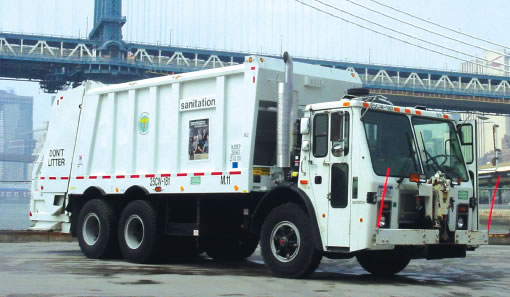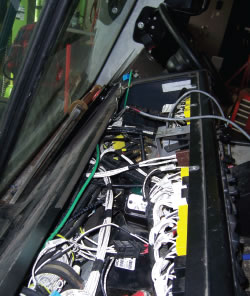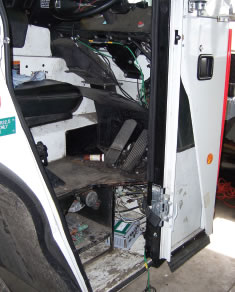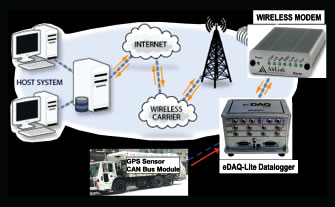Saving Fuel with Wireless DA
Wireless data acquisition from nCode plays a key role in U.S.Department of Energy projects.
Latest News
August 27, 2007
By Diane Bell
The need to cut fuel consumption and exhaust emissions is a hot topic these days for both heavy truck operators as well as heavy truck OEMs seeking ways to reduce costs without compromising the performance and capability of their fleets. And as public demand for cleaner and quieter vehicles grows, especially in urban areas, heavy truck manufacturers are investing in R&D to develop heavy-duty vehicles that meet the public’s needs as well as the future needs of vehicle owner and operators.
 New York City Sanitation trucks are guinea pigs in a program studying hydraulic regenerative braking to cut emissions, fuel use, and noise. |
A new technology called hydraulic regenerative braking (HRB) might hold the promise of a solution to these challenges. HRB has the potential to significantly reduce fuel consumption, emissions, noise, and overall vehicle operating costs by capturing a vehicle’s kinetic energy during braking that would otherwise be lost as waste heat.
 This ignition relay in one of the study trucks includes nCode’s eDAQ-Lite high-speed data acquisition system that transits collected data from the streets of New York to New West Technologies in Landover,Maryland. |
During braking, a hydraulic pump/motor integrated into the vehicle’s driveline acts as a pump, directing hydraulic fluid into an accumulator. After a full stop when the truck starts to accelerate, the accumulator releases the stored compressed fluid in a controlled manner, now driving the motor. This, in turn, effectively reduces the load on the combustion engine, thereby increasing efficiency.
Federal, state, and local governments have not been oblivious to the demands for cleaner, quieter, more efficient vehicles to replace the thousands of heavy-duty trucks plying America’s city streets today. To that end, industry and the U.S. Department of Energy, along with the New York State Energy Research and Development Authority, are jointly sponsoring a landmark project — titled Multi-Fleet Demonstration of Hydraulic Regenerative Braking Technology in Refuse Truck Applications — with the goal of identifying ways to reduce fuel consumption and emissions and reduce overall operating costs through improved vehicle efficiency.
Industry leaders are participating as well, with Bosch Rexroth supplying its Hydrostatic Regenerative Brake (HRB) parallel hydraulic hybrid technology for prototype refuse vehicles for field testing and evaluation, and American LaFrance providing the prototype truck chassis in which the HRB system is installed. Field testing is under way in New York City, the quintessential urban environment for testing HRB technology. The New York City Department of Sanitation (DSNY) collects more than 12,000 tons of refuse daily from its five boroughs along some 6,300 miles in classic stop-and-go traffic.
A key element of this project entails analyzing duty cycle data from a representative conventional DSNY refuse truck so that this data can later be compared to a new prototype hydraulic hybrid truck. New West Technologies LLC of Landover, MD, is providing technical support services for this project, for which data collection is critical. Because the collected data comes directly from the refuse truck, it was critical for New West to use a data acquisition system with a small footprint capable of seamless integration into the truck chassis. In addition, the system needed to be impervious to dirt and water, and rugged enough to withstand the shock and vibration experienced by a fully loaded 72,000-pound refuse truck traveling the potholed streets of New York City. Finally, the system needed superior wireless capability to facilitate accurate and reliable remote monitoring and data acquisition.
|
|
The solution for New West was the rugged and portable SoMat eDAQ-Lite data acquisition system from nCode International of Southfield, MI. It features integrated high-speed wireless data communication capability.
“The ability to have high-speed wireless communication is critical to this project,” says Ziga Ivanic, a project manager in New West’s energy systems division specializing in advanced transportation technologies. “nCode’s eDAQ-Lite system provided a superior overall data collection solution coupled with high-speed wireless communication capability, thus eliminating the need for an on-site engineer to monitor the project,” he adds.
New West is analyzing data and providing Bosch Rexroth with representative truck duty cycle data for the DSNY refuse truck fleet. Bosch Rexroth is particularly interested in vehicle speed profiles, engine operating maps, and the operating characteristics that will allow for appropriate sizing of the hydraulic components and the development of a control strategy for capturing the maximum amount of regenerative braking and reusing it later for vehicle propulsion. Later in the project, New West will conduct comparative tests between the conventional refuse truck and the hydraulic hybrid prototype refuse truck used in DSNY fleet service.
The eDAQ-Lite data acquisition system allows collection of a wide range of analog data directly from sensors, as well as digital data including vehicle network interfaces and GPS. Easily expandable, it offers true configuration ease in creating a user-defined, customized data acquisition solution. A key feature of the eDAQ-Lite is the integrated Ethernet communication port enabling integration of a broadband wireless modem for high-speed wireless (WWAN) remote communication. This was critical for New West engineers who required high-speed wireless communication for remote management of data acquisition and analysis. New West’s use of the eDAQ-Lite system incorporates a third-party high-speed wireless modem for this purpose, which lets engineers easily upload and download data remotely via WWAN high-speed wireless communication.
 The rugged and portable SoMat eDAQ-Lite Datalogger data acquisition system from nCode International records and transmits data about the duty cycle of New York City sanitation trucks for a U.S. Department of Energy project aimed at reducing fuel consumption, truck noise, and emissions. |
“nCode’s eDAQ-Lite solution allows the flexibility for employing high-speed WWAN wireless Ethernet connection for super fast communication — up to 400 KBps for uploading and downloading at 156 KBps,” Ivanic says. “We’re extremely pleased with the overall performance.” New West is conducting these tests in New York City where it is routine to have RSSI signal strength of 50dBm, allowing engineers to download a 2MB file representing approximately a day’s worth of data in only a couple of minutes.
New West realized the cost savings from remote data retrieval early on. At one point, reviewing a new test’s data at the end of the day indicated they’d lost the vehicle bus data. An on-site engineer determined the next day that one of the eDAQ-Lite cables had been inadvertently loosened the previous day during routine maintenance. Thanks to the remote data retrieval capability, New West could identify and correct this problem immediately rather than days later.
Remotely retrieving data is one thing; remote test setup and management is quite another, especially when using proprietary test software becomes difficult due to corporate firewall security blocking access to outside IP addresses. nCode’s own Test Control Environment (TCE) is an elegant solution to this problem: thanks to eDAQ-Lite’s Ethernet connectivity capability, New West can access an eDAQ-Lite web page, allowing it to download and analyze data without requiring TCE be loaded on the PC. “Using a web browser without TCE on the PC means we can look at individual data sets, runs, parameters, and download only that information we need,” says Ivanic. “The backup is all on the eDAQ-Lite, which gives us a lot of peace of mind.”
GPS capability is a growing requirement, and has been especially helpful to New West in the course of this project. For example, the eDAQ-Lite’s GPS capability allows communication with and immediate identification and location of a test specimen without the need for on-site personnel to physically find the test vehicle.
A project of this scope would have been extremely time-consuming and expensive without the use of high-speed wireless communication, coupled with the flexible and expandable data collection capabilities of the eDAQ-Lite solution. Not only is it a compact, rugged, expandable data acquisition system with high-speed wireless capability, it’s also a highly reliable solution.
New West reports that after ten months it hasn’t had a single interruption that required onsite intervention; a pleasant prospect as it prepares to begin the second phase of the project at the end of this year. Another nCode eDAQ-Lite data acquisition system will be used to outfit a prototype hydraulic hybrid truck to do comparative testing.
Dianne Bell is an avid cyclist and mother of an active 18-month-old son, and a marketing consultant and freelance writer based in Minneapolis, MN, focusing on test and measurement technology and overall engineering software. You can send comments about this article to DE-Editorsmailto:[email protected].
Subscribe to our FREE magazine, FREE email newsletters or both!
Latest News
About the Author
DE’s editors contribute news and new product announcements to Digital Engineering.
Press releases may be sent to them via [email protected].







